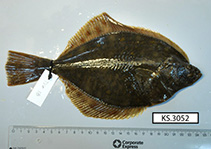| Family: |
Pleuronectidae (Righteye flounders), subfamily: Pleuronectinae |
| Max. size: |
26.69 cm SL (male/unsexed); 21.38 cm SL (female) |
| Environment: |
demersal; brackish; depth range 0 - 50 m |
| Distribution: |
Northeast Atlantic: endemic to the Baltic Sea. |
| Diagnosis: |
Dorsal soft rays (total): 46-59; Anal soft rays: 35-41; Vertebrae: 33-35. This species is distinguished from all its congeners by the following: differs from P. stellatus by the absence of stripes on the dorsal and anal fin rays (vs. presence); differs from P. flesus with more than 99.999% certainty using genotypes of at least three of the outlier loci which were genotyped in this study (Loci 886, 3599, and 1822), with dorsal-fin rays 46-59 (vs. 51-66) and anal-fin rays 35-41 (vs. 35-45). Reproductive traits (viz. egg morphology and buoyancy, as well as sperm physiology) are distinct diagnostic characters with eggs of P. solemdali become neutrally buoyant at salinities between 16 and 21.5 psu and are 0.99 ± 0.05 mm in diameter, whereas the eggs of P. flesus in the Baltic Sea are larger, 1.3-1.5 mm, and reach neutral buoyancy between 11 and 18 psu). Spermatozoa of P. solemdalis activate at minimum salinities between 2 and 4 psu (vs. required salinity above 10 psu for P. flesus) (Ref. 119386). |
| Biology: |
This demersal species has been reported to have adults reside in the archipelago and coastal areas throughout their lives undertaking only limited migrations between deeper wintering grounds and shallower spawning and feeding areas. It lives in brackish water of varying salinities at 0.5 to 50 m depth on soft and hard bottoms. It is a benthivore, feeding on various mussels and other benthic invertebrates from its postsettled juvenile stage. Spawning occurs in April to June in nearshore areas 5-20 m depth, preferred water temperature of around 8°C. Mature females are reported lay up to 2 million relatively small eggs after fertilization develop on the bottom, above stony, sandy, or vegetated substrates. Little is known about its larval phase, while early development and juvenile habitat use generally resembles the common features of flatfishes. There are no studies specifically done on age and length at maturity for demersal Baltic flounder. However, around Gotland in the central Baltic Sea (SD 28) where both P. flesus and P. solemdali species co-occur, female flounders recruit to the adult population and attain maturity around the age of 3 years (range: 2-5) at a length of 20-25 cm, while males often maturing earlier (2-3 years) than females (3-4 years) (Ref. 119386). |
| IUCN Red List Status: |
Not Evaluated (N.E.) Ref. (130435)
|
| Threat to humans: |
harmless |
Source and more info: www.fishbase.org. For personal, classroom, and other internal use only. Not for publication.

